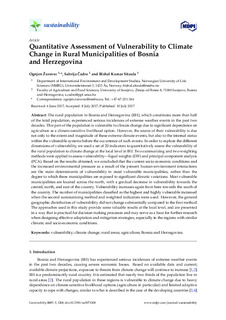| dc.description.abstract | The rural population in Bosnia and Herzegovina (BH), which constitutes more than half of the total population, experienced serious incidences of extreme weather events in the past two decades. This part of the population is vulnerable to climate change due to significant dependence on agriculture as a climate-sensitive livelihood option. However, the source of their vulnerability is due not only to the extent and magnitude of these extreme climate events, but also to the internal status within the vulnerable systems before the occurrence of such events. In order to explore the different dimensions of vulnerability, we used a set of 20 indicators to quantitatively assess the vulnerability of the rural population to climate change at the local level in BH. Two summarizing and two weighting methods were applied to assess vulnerability—Equal weights (EW) and principal component analysis (PCA). Based on the results obtained, we concluded that the current socio-economic conditions and the increased environmental pressure as a result of the present human-environment interactions are the main determinants of vulnerability in most vulnerable municipalities, rather than the degree to which these municipalities are exposed to significant climatic variations. Most vulnerable municipalities are located across the north, with a gradual decrease in vulnerability towards the central, north, and east of the country. Vulnerability increases again from here towards the south of the country. The number of municipalities classified as the highest and highly vulnerable increased when the second summarizing method and weighted indicators were used. However, the general geographic distribution of vulnerability did not change substantially compared to the first method. The approaches used in this study provide some valuable results at the local level, and are presented in a way that is practical for decision-making processes and may serve as a base for further research when designing effective adaptation and mitigation strategies, especially in the regions with similar climatic and socio-economic conditions. | nb_NO |

